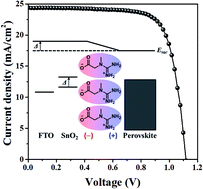Novel cathode interfacial layer using creatine for enhancing the photovoltaic properties of perovskite solar cells†
Abstract
With the unprecedented development of perovskite solar cells (PSCs), various interlayers have been investigated. Interlayers have diverse roles in shifting the energy levels, attracting and extracting charges, and passivating surface traps. These can improve the stability of PSCs, as well as their power conversion efficiency (PCE). In this study, a small molecular self-assembled monolayer (2-[carbamimidoyl(methyl)amino]acetic acid) is introduced on a SnO2 layer. The acetic acid is known as creatine, existing naturally in the human body. It is eatable and dosed by athletes for energy. Due to its structural properties, creatine can be anchored on a SnO2 layer, thus, it can strengthen the charge extraction from a perovskite layer by forming interface dipoles and reducing the work function. Also, it can passivate the defects in the perovskite layer. These properties are comprehensively investigated via various experimental techniques. With the creatine layer as a cathode interfacial layer on the SnO2 layer, the PSC employing a triple cation-based perovskite achieves the highest PCE of 20.8% and retained 90% of it after 50 days. Furthermore, 22.1% of PCE is obtained from the formamidinium-based perovskite. This report represents an interesting application of creatine as an interlayer in PSCs and suggests the possible application of other essential amino acids.



 Please wait while we load your content...
Please wait while we load your content...